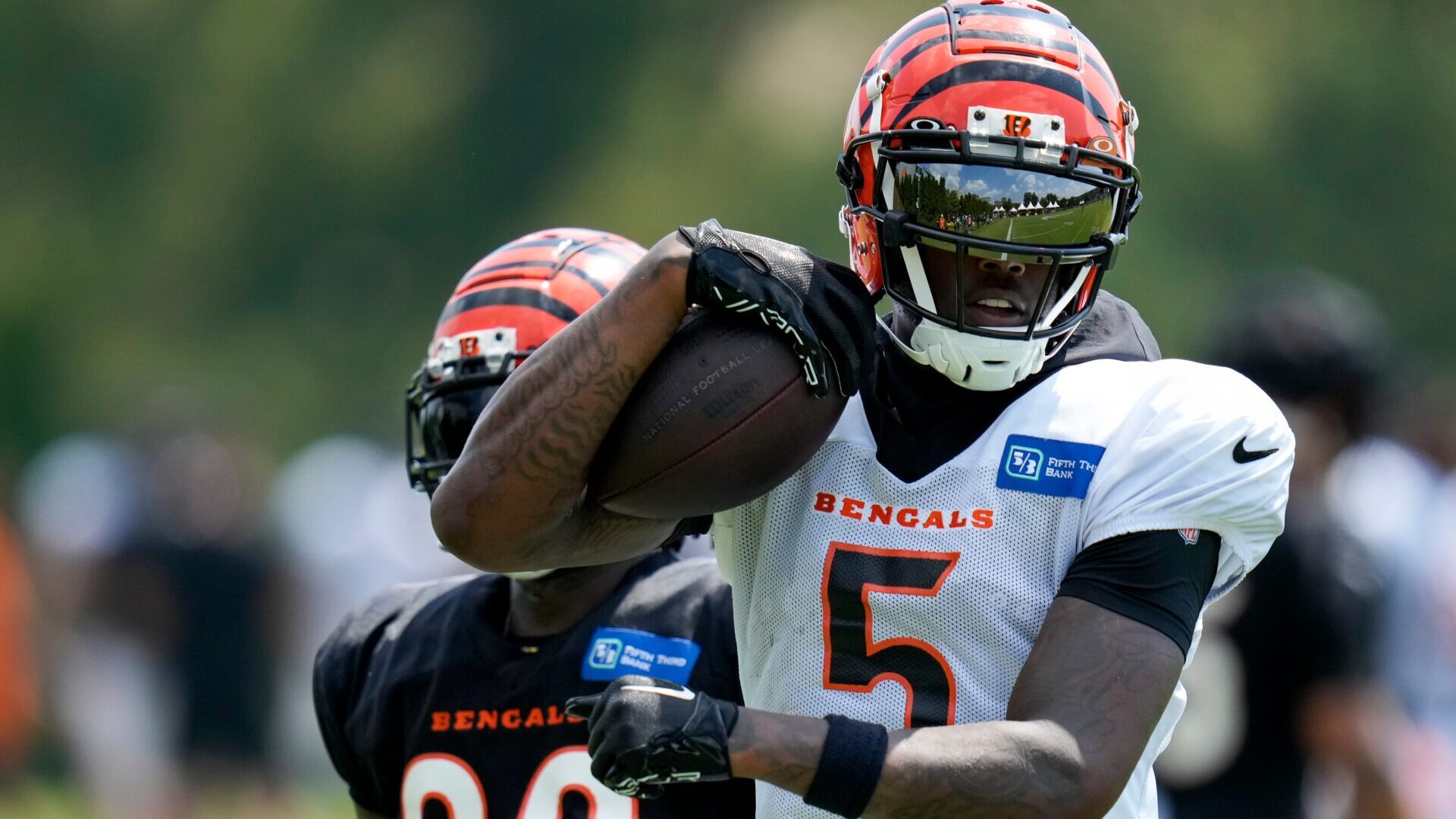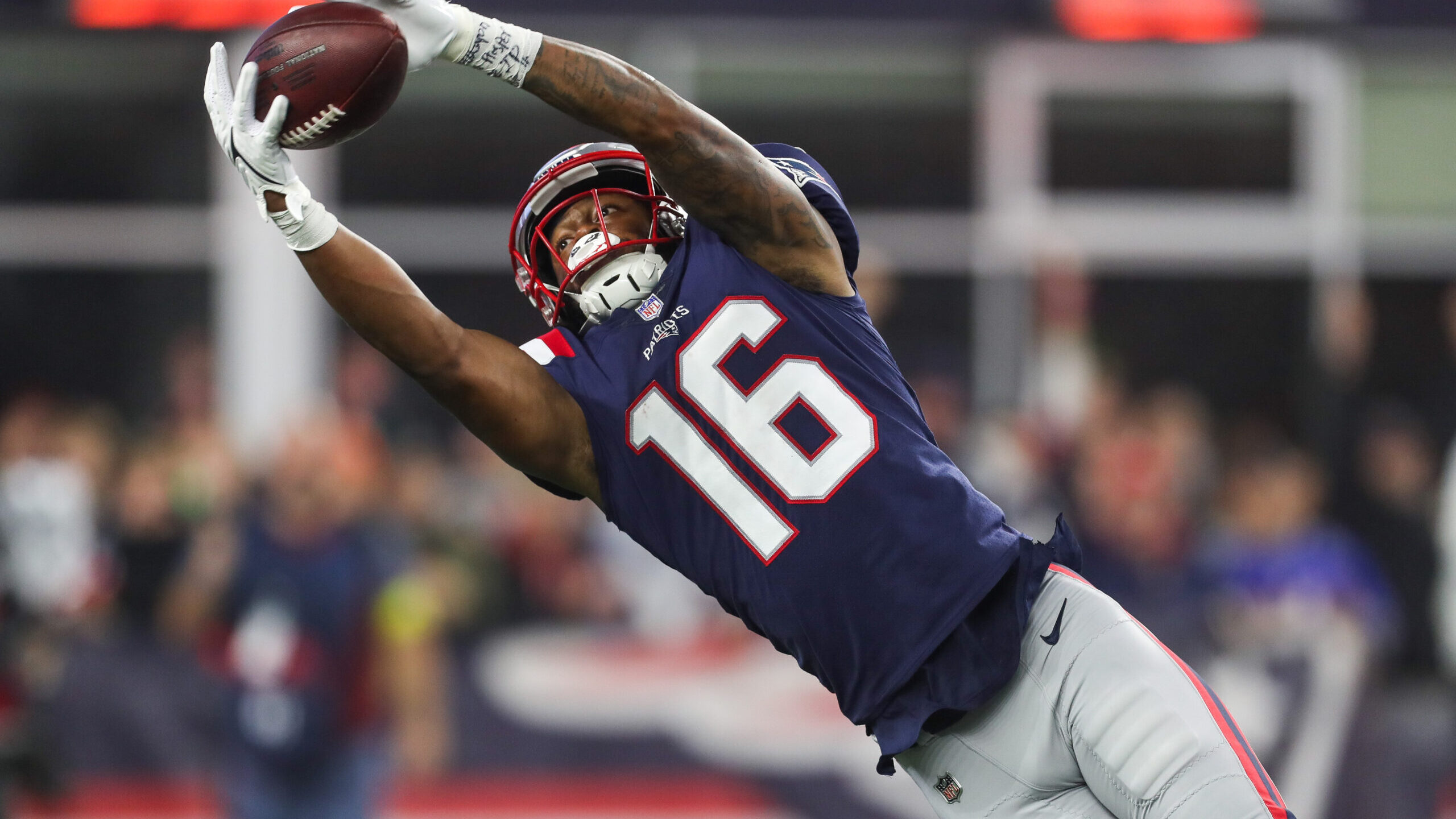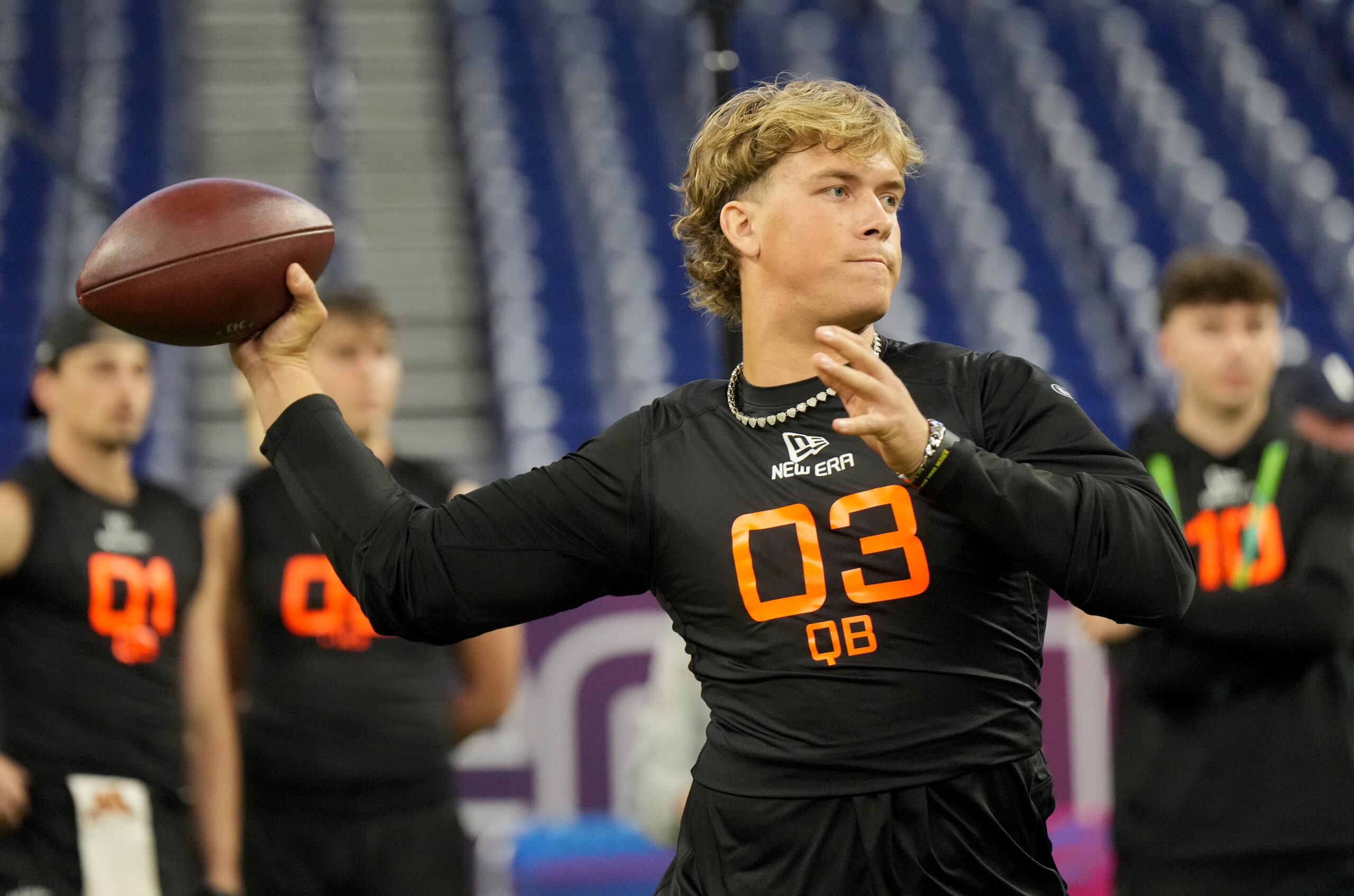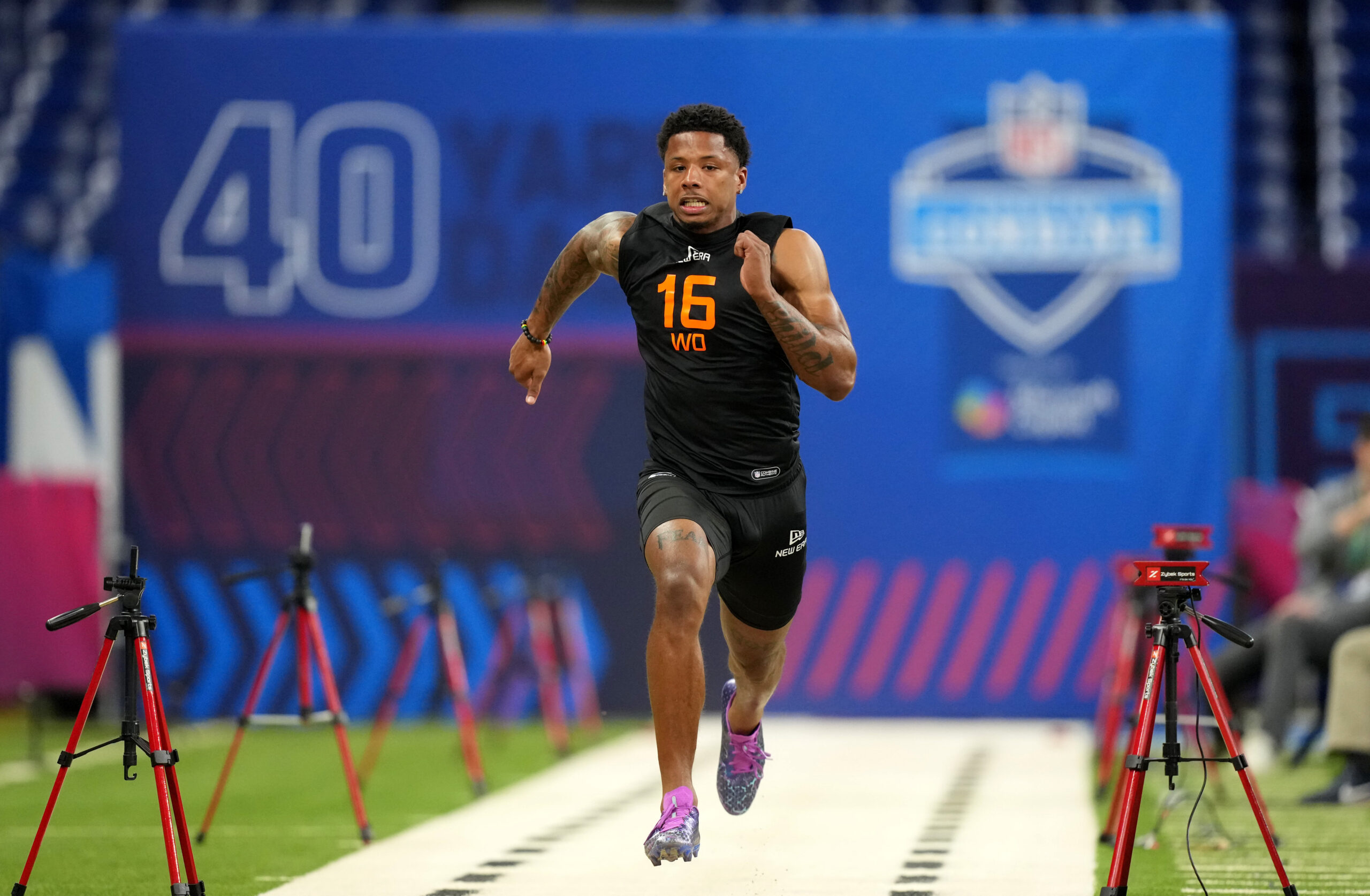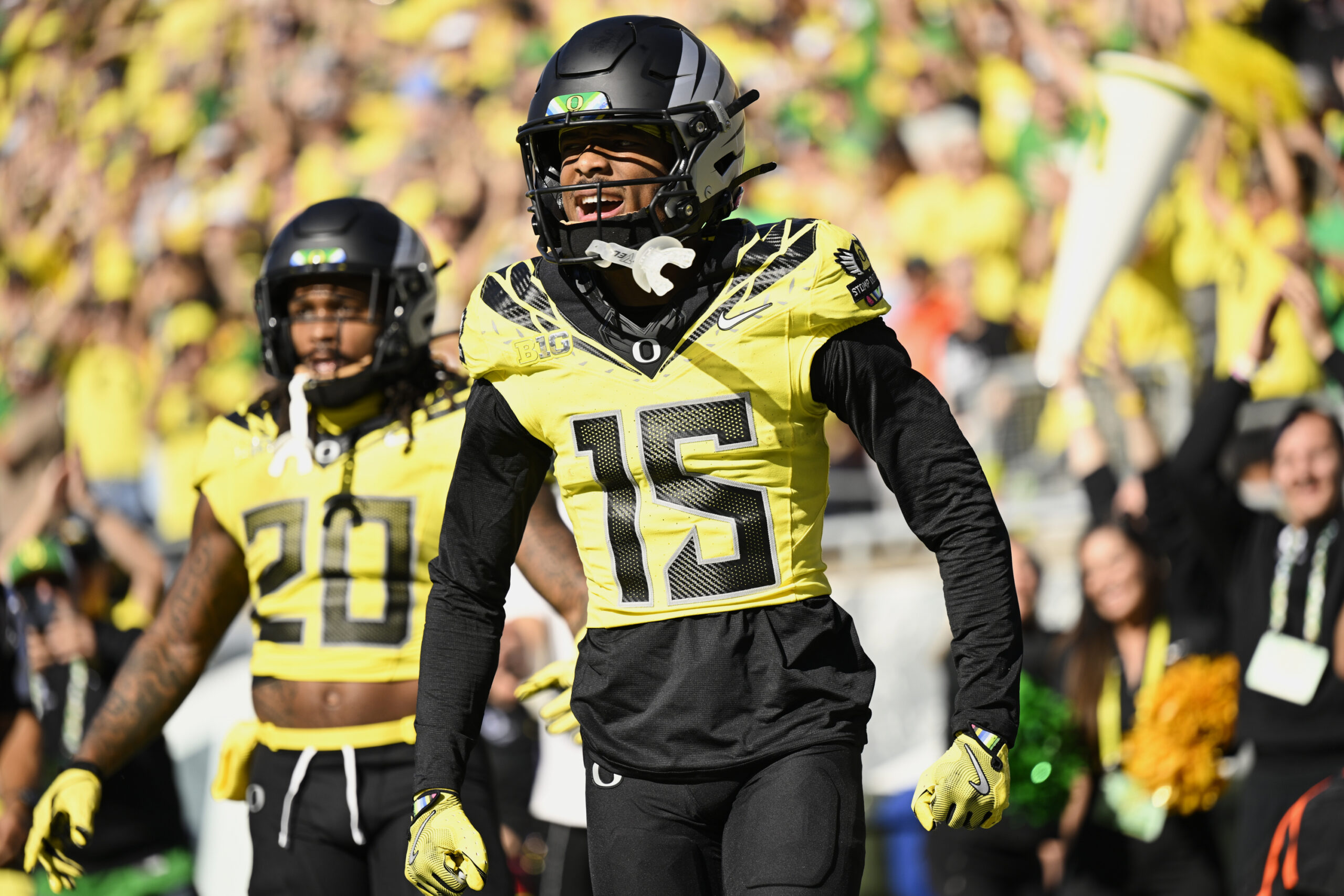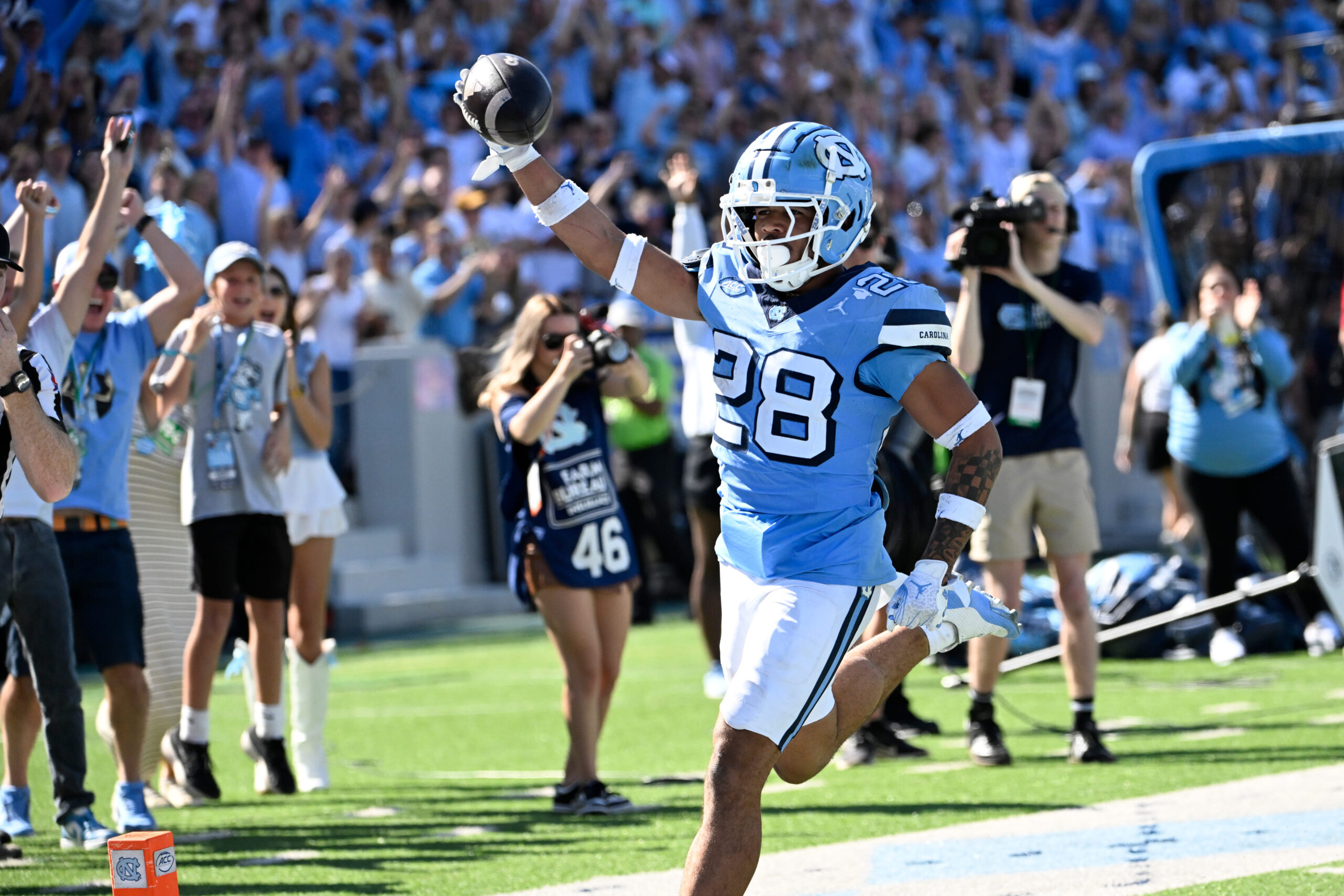Analysis
8/8/23
43 min read
Top 68 Fantasy Football Wide Receiver Rankings for 2023 NFL Season
These top 68 fantasy wide receiver rankings are intended for half-PPR and PPR (point per reception) leagues. Every player includes a detailed write-up to provide context behind their ranking. Players within tiers can be rearranged to your preference and are there to help you understand where I’m viewing cut-off points.
Other Fantasy Rankings: Top 33 QBs | Top 25 TEs | Top 55 RBs
All fantasy points cited throughout use PPR fantasy scoring.
We recently welcomed NFL insider Ari Meirov on the podcast to discuss his views on all the situations to monitor for fantasy managers. This podcast covered all 16 NFC teams. Check back Thursday, Aug. 10 for the AFC version.
Tier 1: Overall WR1 Contenders
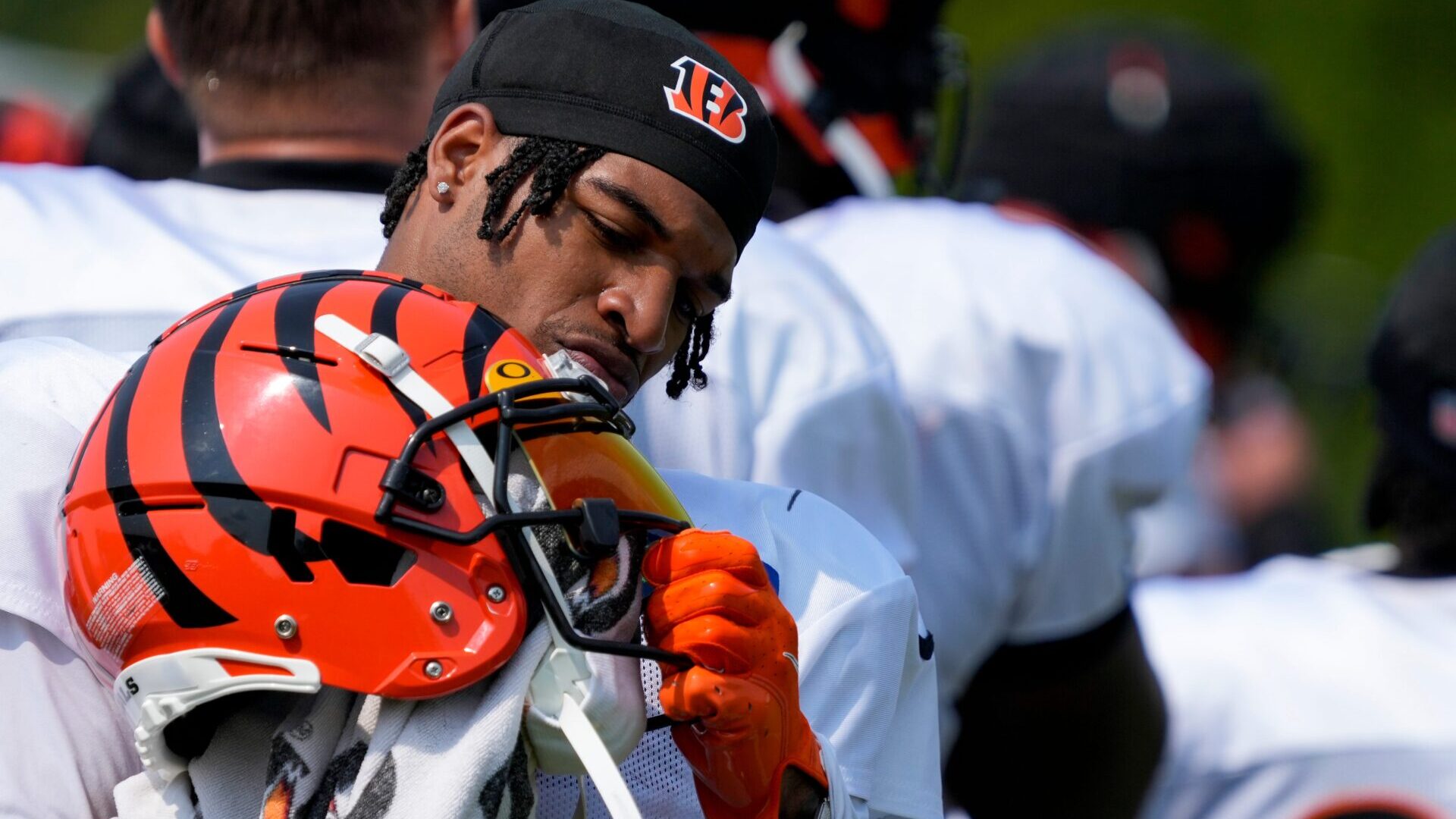
1. Ja’Marr Chase, Cincinnati Bengals
Ja'Marr Chase set the record for yards receiving as a rookie in 2021, then led all wide receivers in targets per game in 2022. He averaged more than 20 PPR fantasy points per game last year despite playing through a broken hip and does not have as much competition for targets as Justin Jefferson.
Tee Higgins is one of the NFL’s best No. 2 receivers, but Tyler Boyd has quietly seen his targets and yards per game decline in four straight seasons. TE Irv Smith has never reached 30 yards per game in any season. Chase plays on one of the NFL’s best passing offenses and has elite speed and ability after the catch. Everything is lining up for him to be fantasy’s top receiving option in 2023.
2. Justin Jefferson, Minnesota Vikings
Jefferson has averaged 1,608 yards receiving during his three NFL seasons, a higher number than Davante Adams’ best season. Jefferson led the NFL in targets (184), receptions (128), and yards receiving (1,809) in 2022, finishing with the second-most fantasy points per game (21.7) behind only Cooper Kupp.
His floor is incredibly high, but the ceiling case appears lowered for 2023. TE T.J. Hockenson averaged 9.4 targets (more than Travis Kelce) per game during his nine full games as a Viking last season, and the team drafted WR Jordan Addison in Round 1 of the most recent NFL draft. This is steeper target competition than Chase contends with, and the Minnesota Vikings offense will likely score fewer points than the Cincinnati Bengals in 2023.
3. Tyreek Hill, Miami Dolphins
Tyreek Hill set career-highs in targets (170), receptions (119), and yards (1,710) in his first season in Miami, finishing with 20.1 fantasy points per game. He also led all wide receivers with 3.25 yards per route run, despite playing with three different quarterbacks last year.
If QB Tua Tagovailoa stays healthy for all of 2023, Hill has a chance to replicate, if not surpass, his 2022 campaign. This is still a pass-first offense where Jaylen Waddle is the only other viable target earner. Hill is now 29-and-a-half years old, so it’s worth mentioning there could be some age-related decline; however, nothing from last season suggests we should expect a dip in production.
4. Cooper Kupp, Los Angeles Rams
Cooper Kupp has led all wide receivers in PPR fantasy points per game in the past two seasons, finishing with 25.9 and 22.4, respectively, in 2021 and 2022. He underwent surgery on his sprained ankle, missed half last season, and most recently suffered a hamstring injury during training camp. He’s now 30, and the Los Angeles Rams showcased a scary floor as a team last year.
However, there is minimal target competition for Kupp, and QB Matthew Stafford is healthy again. The Rams should have the NFL’s worst pass defense by a comfortable margin in 2023, so expect pass-heavy game plans and negative game script. The floor for Kupp is lower than the three receivers ahead of him, but again, he’s still finished as the top fantasy receiver per game in back-to-back seasons.
If you haven’t already, make sure you join our FREE Discord to chat fantasy football all offseason. In season, we’ll drop player prop bets each week, along with DFS showdown AMAs and start-sit help.
Tier 2: Should Finish as Fantasy WR1s
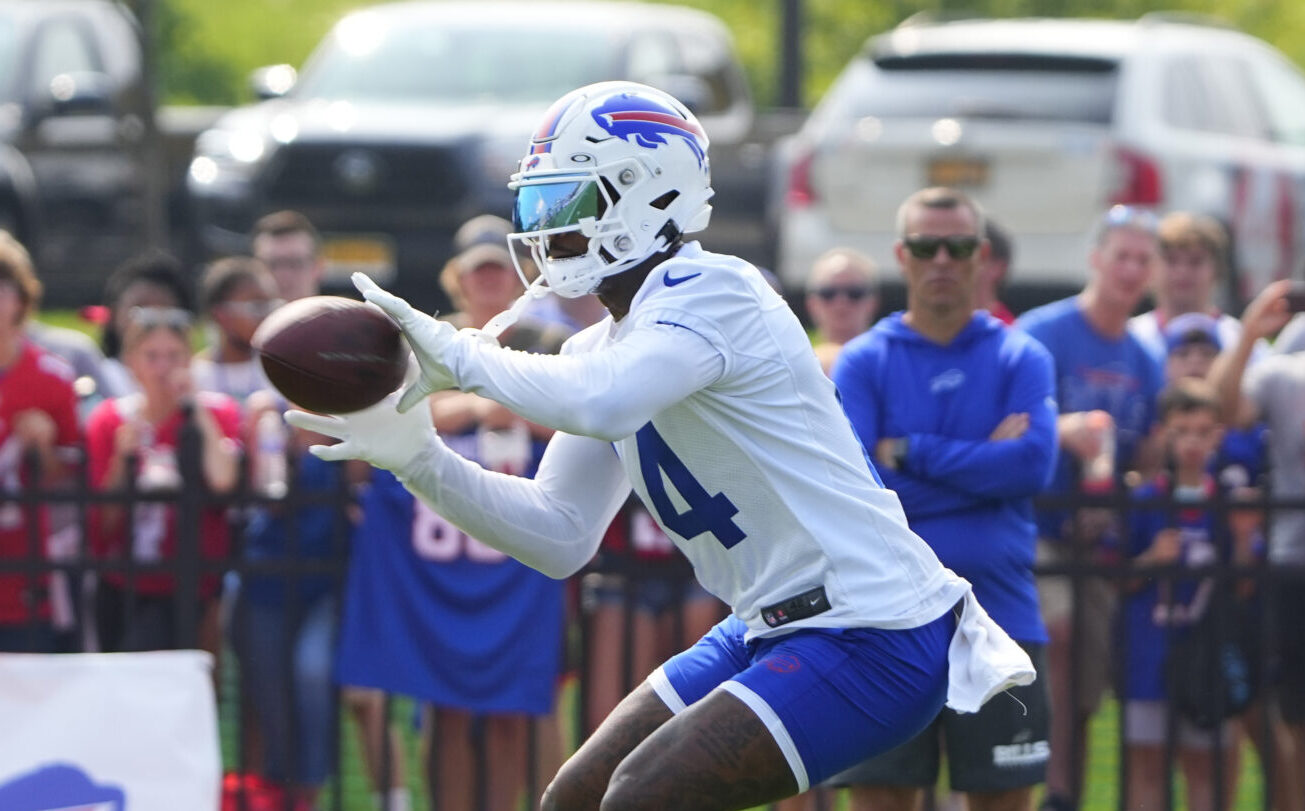
5. Stefon Diggs, Buffalo Bills
Stefon Diggs has averaged 161 targets, 113 receptions, 1,396 yards and 10 touchdowns during his three seasons in Buffalo (WR3, WR9, and WR5 finishes). The Buffalo Bills still have no true target competition, with Gabe Davis again slotting in as the team’s second receiving option. Competition is tougher in the AFC East too, with Aaron Rodgers heading to the New York Jets and the Dolphins revamping the defense and hoping for better health from Tagovailoa — expect more shootout game conditions than last season.
Diggs turns 30 during the season, so there’s a chance for age-related decline, but like Hill and Kupp, we haven't seen any signs of that yet. Josh Allen’s top option should go toward the end of Round 1 in fantasy drafts.
6. CeeDee Lamb, Dallas Cowboys
CeeDee Lamb took a massive step forward in Year 3, as his target share (20.5 percent to 28.7 percent) and targets per route run (23.7 percent to 28.6 percent) ballooned, despite his average target depth remaining largely unchanged (10.4 yards to 10.2 yards). This resulted in a fantasy points per game increase from 14.6 in 2021 to 17.7 in 2022.
New Dallas Cowboys WR Brandin Cooks adds target competition, and Michael Gallup is now two years removed from his ACL tear. However, Lamb’s target share and targets per route run were better than Jefferson last year, despite having the same average target depth. Lamb would have been a candidate for Tier 1 if the Cowboys had retained offensive coordinator Kellen Moore, who is now with the Chargers. Diggs and Lamb are largely interchangeable in these rankings.
7. Amon-Ra St. Brown, Detroit Lions
Amon-Ra St. Brown has played in 20 games from Week 13 of 2021 onward with a snap share of at least 50 percent. He’s averaged 20.6 PPR fantasy points per game over that stretch, which would have ranked third behind only Kupp (22.4) and Jefferson (21.7) last season. This 20-game sample saw him see 10.3 targets, 7.6 receptions, and 85 yards receiving per game, more than 16 fantasy points before factoring in his touchdowns scored.
The Detroit Lions passed 588 times last season, good for 10th in the NFL. However, they ran the ball 480 times, a pass rate of just 55 percent, at least two percentage points above every other team in the top-15 for pass attempts. Looking ahead, there’s a good chance the Lions — and their fifth-best scoring offense — throw more in 2023, with St. Brown the biggest beneficiary.
Jameson Williams will return after a six-game suspension, but the two receivers operate in different parts of the field, with St. Brown in the slot handling the short-to-intermediate region and Williams out wide running deeper routes. It’s tough to see St. Brown doing anything other than commanding targets and continuing to score fantasy points in this Lions offense.
8. Garrett Wilson, New York Jets
Garrett Wilson had 1,100 yards receiving as a rookie, playing with three (bad) quarterbacks: Joe Flacco, Zach Wilson and Mike White. He now gets to play 17 games with Aaron Rodgers. While the pass volume should drop from sixth last year (627 attempts) to near league average (Packers were 18th with 563 attempts), the target quality should rise dramatically.
Wilson’s catch rate was an abysmal 56.5 percent last year, while Davante Adams was at 65 percent or higher in his final four years with Rodgers. No other receiver on this roster should threaten Wilson for the target lead, and he can presumably build upon his 25 percent rookie year target share.
9. A.J. Brown, Philadelphia Eagles
A.J. Brown’s chemistry with QB Jalen Hurts was evident in his first season in Philadelphia, as he set career-highs in targets (145), receptions (88), yards receiving (1,496), and touchdowns (11). Only Tyreek Hill had a better combination of target share and average target depth than Brown, who was fifth in the league with 17.0 yards per reception.
Despite all the touchdowns and the high efficiency, Brown only finished as the WR8 in fantasy points per game (17.6). It’s tough to see a scenario where his 2023 season is even better, and the players ranked ahead of Brown have a clearer path to top-three fantasy upside.
10. Jaylen Waddle, Miami Dolphins
Waddle was Miami’s short-area target in 2021 when he set the rookie receptions record (104). Then, he was successful as a deep threat in 2022, leading the league with 18.1 yards per reception and finishing with 1,356 yards receiving. Hill is the top dog in this pass attack, but Waddle is close behind and has an incredibly high floor, given his youth and ability to win in all areas of the field.
Should anything happen to the 29-year-old Hill, Waddle could challenge the Tier 1 guys for the fantasy points per game crown. His floor is high-end fantasy WR2, and the ceiling is WR1 overall should Hill go down due to injury.
11. Davante Adams, Las Vegas Raiders
Adams has scored at least 17.7 fantasy points per game each of the past six seasons, which at face value shows his floor has been higher than A.J. Brown’s ceiling. However, numerous forces are working against Adams for 2023.
He reportedly wants out of Las Vegas now that Derek Carr is in New Orleans, and new Raiders QB Jimmy Garoppolo is a steep downgrade. Adams is currently 30 and will turn 31 in late December - very few receivers have put up elite fantasy seasons this late in their career. Adams saw his catch rate drop from more than 72 percent in 2020 and 2021 to 55.6 percent in 2022. A career-high 180 targets buoyed his fantasy production; however, Garoppolo has never been in charge of high-volume passing offenses before, and the Raiders likely don’t air it out as much in 2023.
Additionally, the Raiders are sneaky “contenders” for the No. 1 pick in the 2024 NFL Draft. This is shaping up to be a lost season for the Raiders, and I’m pessimistic about the offense’s outlook and its ability to support a fantasy WR1 like Adams.
12. Chris Olave, New Orleans Saints
Chris Olave’s rookie target share was actually slightly higher than Garrett Wilson’s - at a much higher average target depth, and Olave also averaged five more yards receiving per game. Unlike Wilson, Olave will catch passes from Carr, who is not the caliber of future Hall of Famer Rodgers. Olave will also contend with Michael Thomas for targets, and Thomas hovered around a 20 percent target share in limited action last season.
Olave is a safe bet for fantasy production after his elite rookie season, but it’s more difficult to picture a high-end fantasy WR1 finish from him than the others in this tier. Andy Dalton was secretly more efficient than Carr as a passer last year, and the Saints’ pass volume may not be there, as the team has the NFL’s easiest schedule in 2023.
Tier 3: Chance at a Top-12 Fantasy Finish
13. Tee Higgins, Cincinnati Bengals
Higgins has seen from 108-110 targets during all three NFL seasons, remarkable consistency made possible by injuries. After 78 yards per game in 2021, Higgins dipped to 64 per game last year.
Digging in a little deeper, Higgins played fewer than 30 percent of the snaps in three games due to injuries in 2022, which masked his strong numbers in the other 13 games. Removing those three games and the minimal receiving stats from each, Higgins actually averaged 77 yards per game, which would make back-to-back seasons where he paced for more than 1,300 yards over a 17-game season.
If Chase goes down, Higgins rises to mid-range WR1 status. Even with a fully healthy Chase, Higgins should realistically have some version of AJ Brown’s 2022 fantasy season this upcoming year.
14. DeVonta Smith, Philadelphia Eagles
Through nine games, DeVonta Smith had the edge over TE Dallas Goedert in targets per game (6.8 to 5.9), though Goedert turned that into 60 yards per game compared to Smith’s 53. Smith then averaged 9.4 targets and 89 yards per game over the next eight games, with Goedert missing five of those contests. There’s a chance this is just a small sample size issue, but it’s worth mentioning when drafting Smith so early in fantasy.
Smith is young and just set the Philadelphia Eagles’ receptions record in 2022, so the floor should be high. Most likely, we see Smith produce in-between those two splits from last year. He’s a high-end WR2 with WR1 upside if the oft-injured Brown goes down with injury. I’m not excited to draft him, but I’m also not fading him at the back-end of Round 2 in drafts.
15. Keenan Allen, Los Angeles Chargers
Keenan Allen only played eight healthy games in 2022 (Weeks 11-18). During that span, he paced for 176 targets, 128 receptions, 1,434 yards and eight touchdowns. Only Chase, Jefferson, and Adams performed better than Allen’s 18.8 fantasy points per game in the second half of last season.
The Los Angeles Chargers have finished top three in pass attempts each of the past two years, and now bring in Kellen Moore from Dallas as their offensive coordinator. Dak Prescott was one of three quarterbacks to operate at a faster pace than Justin Herbert last year, and Prescott’s average throw depth was far higher, too. Expect another season of high volume, but with increased efficiency, for this Chargers passing game. Allen should be the primary beneficiary of the offensive coordinator switch, and the concerns with him are purely age and injuries. If Allen stays healthy, he should finish as a fantasy WR1.
16. Calvin Ridley, Jacksonville Jaguars
Calvin Ridley’s 18.8 fantasy points per game from 2020 would have ranked WR7 last season, between Adams and Lamb. In 2021, Ridley played five games on a broken foot, and still managed a top 10 target share in the process. He hasn’t played since because of a gambling suspension, but he does get a quarterback upgrade, going from late-career Matt Ryan to 2023 MVP contender Trevor Lawrence.
Christian Kirk was a high-end WR2 in Jacksonville last year, despite peripherals that are all much lower than Ridley’s 2020 and 2021 seasons. All reports out of training camp are that Ridley is the team’s best player in receiving drills. There’s some risk since he hasn’t played since early 2021, but he’s fully healthy for the first time in three years, and now gets to play in one of the NFL’s best passing offenses.
17. Amari Cooper, Cleveland Browns
Amari Cooper had a career-high 26 percent target share in his first season in Cleveland, turning that into 78 receptions, 1,160 yards, nine touchdowns and 14.5 fantasy points per game. The target competition is stiffer heading into 2023, with WR Elijah Moore coming over from the Jets. Fortunately for Cooper, he now gets a full season with Deshaun Watson.
The last time we saw a full season from Watson in 2020, he led the NFL in yards passing. Playing behind the Browns elite offensive line, with an entire offseason to now learn the playbook, expect Watson to bounce back, with Cooper the main recipient of the fantasy points. He’s a high-floor fantasy WR2 with a chance to crack the top-12 if Watson returns 100 percent to form.
18. DK Metcalf, Seattle Seahawks
DK Metcalf’s fantasy points dipped in 2022 despite a strong showing from Geno Smith. Looking closer, Metcalf’s career-low six touchdown receptions appear to be the culprit. Metcalf actually had the most targets and receptions of his career in 2022. Tyler Lockett is expected to move out wide, with rookie WR Jaxon Smith-Njigba manning the slot. Defenses won’t be able to key in on all three at once, and Metcalf is one of the NFL’s best at exploiting mismatches.
It’s hard to know exactly how the targets shake out for the Seattle Seahawks, but expect Metcalf to lead the group, and to do it much more efficiently than in 2022. The floor is reduced with the added target competition, but Metcalf still has a top-12 ceiling if the touchdowns break right for him, like they did in 2020 and 2021.
19. DeAndre Hopkins, Tennessee Titans
DeAndre Hopkins missed the first six games of 2022 because of a PED suspension, and then made up for lost time, commanding nearly 11 targets per game. While part of that was due to the Arizona Cardinals’ pass volume, his target share still ranked sixth-best at the position.
Hopkins is now with the Tennessee Titans, and the passing offense could be less fruitful than it was in Arizona last season. Working in Hopkins’ favor is Ryan Tannehill threw for 33 touchdowns as recently as 2020, a number that would have ranked fourth last year. Additionally, while a terrible offensive line often works against an offense, Hopkins’ likely usage as a short area receiver could actually work in his favor if Tannehill is pressured early and not given ample time to throw. Working against him is a team that has consistently ranked near the bottom of the league in pass attempts.
Hopkins contains risk given his age and recent struggles to stay on the field. However, his team situation isn’t particularly concerning when he goes in Round 4 and 5 of redraft. He should be a high-end WR2 when healthy, who could see a touchdown spike if defenses key in too much on RB Derrick Henry at the goal line.
20. Jerry Jeudy, Denver Broncos
Jerry Jeudy once again dealt with injuries in 2022, and while he played in 15 games, he left three of them after playing less than 40 percent of the team’s offensive snaps. In his 12 healthy games, Jeudy commanded 7.7 targets, 5.2 receptions, 75 yards and 0.5 touchdowns per game, which translates to 16 fantasy points — often the demarcation point between WR1 and WR2 fantasy production.
Put differently, we saw Jeudy put up low-end WR1 numbers on a Denver Broncos offense that scored the fewest points in football, and saw its head coach get fired midseason. QB Russell Wilson and this offense should bounce back with new head coach Sean Payton coming into town — Payton was the architect behind those exciting Saints offenses with Drew Brees — and I expect Jeudy to flirt with WR1 numbers this season.
If you want more fantasy rankings, you can view my top-25 fantasy tight end rankings here.
Tier 4: The Fantasy WR2s
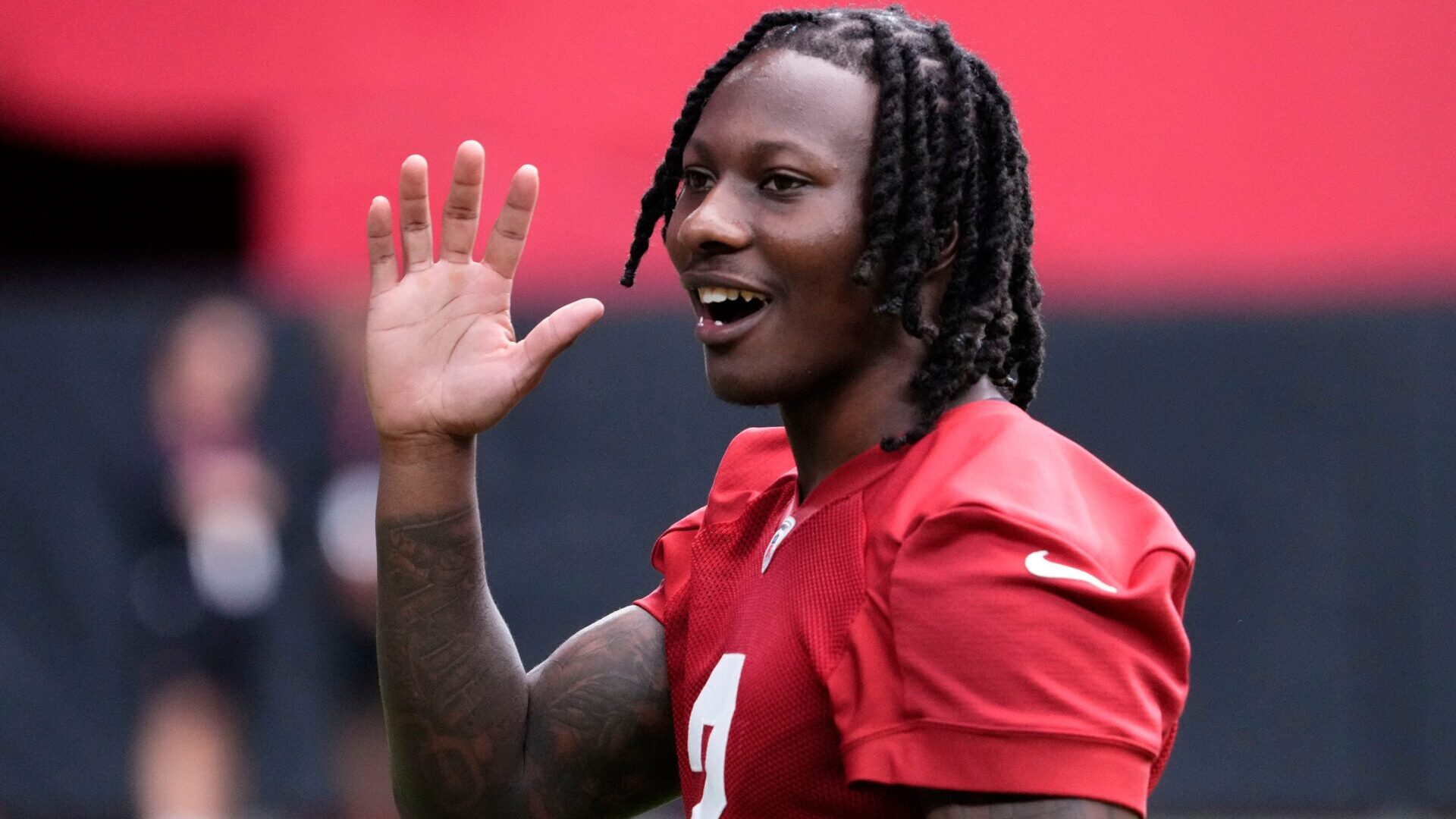
21. Marquise Brown, Arizona Cardinals
This is probably the highest you’ve seen anyone rank Marquise Brown for fantasy football, but he looks like the single-most mis-priced receiver in all of fantasy football for 2023.
Brown averaged 10.7 targets, 7.2 receptions, 80.8 yards and 0.5 touchdowns per game through six games before getting injured. Only six receivers averaged more than his 18.3 fantasy points per game during that stretch. Yes, that was with Kyler Murray and with no Hopkins due to suspension.
Brown should be startable in fantasy early in the season due to volume, and when Murray returns from injury, Brown will find himself in the same situation that led to 18.3 fantasy points per game last year — right when it matters most for the fantasy playoffs. Brown should be a volume-based WR2/WR3 for fantasy until Murray’s return, when he will switch over into league winner territory.
22. Christian Watson, Green Bay Packers
Christian Watson would be in consideration for Tier 2 were Rodgers still the Green Bay Packers’ quarterback. From Week 10 on, Watson was a full-time starter as a rookie, and in those eight games, he averaged 17.2 fantasy points per contest (ninth best in that span). His 2.78 yards per route run ranked first over those games, and he commanded a healthy, but not elite, 22 percent of the team’s targets. Zay Jones had a 22 percent target share last year, for context.
Unfortunately for Watson, the volume stats were lacking, and he was fantasy relevant due to touchdowns. He averaged just 6.5 targets per game over that stretch, but he scored a touchdown per game. Underwhelming receivers such as Courtland Sutton, Josh Palmer and Allen Lazard all averaged more than 6.5 targets per game in 2022.
With the steep drop from Rodgers to Jordan Love, Watson needs to take a big step forward to remain a strong fantasy asset. His efficiency was elite last year, but he probably needs to command at least 25 percent of the team’s targets in 2023 to be on the high-end WR2 radar.
23. Mike Williams, Los Angeles Chargers
Big Mike Williams took only a small step back from his 2021 career year. While his season totals dropped significantly, his receptions per game was at 4.8 both years, and his yards per game barely dipped (71.6 to 68.8). Williams is one of the NFL’s best passing offenses, and his downfield role will enable him to deliver fantasy points without an elite target share.
The Chargers added Quentin Johnston in Round 1 of the 2023 NFL Draft, but he’s much more of a finesse player like Watson, than the big clasher than Williams is. The Chargers should run a lot of three wide receiver sets with that trio, and Williams could once again flirt with low-end fantasy WR1 numbers.
24. Brandon Aiyuk, San Francisco 49ers
Brandon Aiyuk is the true No. 1 wide receiver in San Francisco, and he quietly reached 78 receptions, 1,015 yards receiving, and eight touchdowns in 2022. While Deebo Samuel’s 23.9 percent target share led the team, it came on an aDOT of 4.5 yards. Aiyuk’s 22.4 percent target share was at a 10.0 aDOT, so Aiyuk was more than twice as far downfield per target, compared to Deebo.
Deebo Samuel was less involved in the offense once RB Christian McCaffrey arrived, with just 6.7 targets, 2.7 carries, and 11 PPR points per game. Aiyuk faired much better, with 13.8 fantasy points per game while overlapping with McCaffrey. That period of overlap actually saw Deebo’s aDOT decrease to 3.6 yards, which is nearing running back territory.
Think of Samuel as a high volume gadget player, and think of Aiyuk as the No. 1 receiver.
25. Deebo Samuel, San Francisco 49ers
See Aiyuk’s write-up above for Samuel analysis.
26. Terry McLaurin, Washington Commanders
Terry McLaurin saw his overall role decrease from 2021 to 2022, with dips in target share (24.4 percent to 22.7 percent), targets per route run (23.7 percent to 21.9 percent) and aDOT (13.2 to 12.8). Jahan Dotson flashed during his abbreviated rookie campaign and should present stiffer target competition heading into Year 2.
The Washington Commanders still don’t have a solid answer at quarterback, with last year’s fifth-round pick Sam Howell battling veteran journeyman Jacoby Brissett. McLaurin has a solid floor, with at least 120 targets, 77 receptions and 1,053 yards each of the past three years, but it’s difficult to see a strong ceiling for him in 2023.
27. Drake London, Atlanta Falcons
It was a tale of two seasons for Drake London. In 10 overlapping games with TE Kyle Pitts, he averaged 5.8 targets, 3.5 receptions and 37 yards per game. In seven games when Pitts was injured, London averaged 8.4 targets, 5.3 receptions and 70 yards per game. The team drafted RB Bijan Robinson at No. 8 in the recent draft, and will trot out last year’s third-round rookie Desmond Ridder at quarterback.
The Atlanta Falcons project as one of the NFL’s lowest-volume pass attacks. The past 10 years, just four receivers reached top-12 fantasy production on teams that ranked below average in pass attempts, yards passing, and touchdowns passing - which the Falcons comfortably project to do in 2023.
Given the splits for London when Pitts played last year, along with the new running back in town and the likely weak quarterback play, London is a fade in Round 4 and 5. I do not see a path for him to have difference-making fantasy production, and even though he’s a young talented receiver, he likely finishes outside the top-20 at the position.
28. Diontae Johnson, Pittsburgh Steelers
Diontae Johnson had more than 140 targets for the third straight year. Rather than appreciate this feat, fantasy gamers turned against Johnson, since his 147 targets only translated to 86 receptions, 882 yards and no touchdowns. His meager 10.6 fantasy points per game ranked outside the top 40 at the position.
Part of the issue was the switch from Ben Roethlisberger to rookie QB Kenny Pickett. The Pittsburgh Steelers threw 93 more pass attempts in 2021 with Big Ben, about five fewer per game. Most of the issue was simply being on the wrong side of touchdown variance. Johnson actually led the team with 18 red zone targets (TE Pat Freiermuth was second with 13 and no other player had more than seven).
Give Johnson six touchdown receptions last year (after eight and seven the two prior years), and he would have scored the same fantasy points per game as Garrett Wilson last season. We saw a scary floor for Johnson in 2022, but the entire Steelers offense should take a step forward with Pickett in Year 2, and he should once again find the end zone half-a-dozen times. He doesn’t have the 17 fantasy point per game ceiling he did with Roethlisberger in 2021, but we should expect his 2023 season to fall somewhere between his past two campaigns. He’s a fairly standard fantasy WR2 type in 2023.
29. DJ Moore, Chicago Bears
Darnell Mooney had a 25 percent target share last year, a number we should roughly expect from DJ Moore. Mooney averaged just 8.5 fantasy points and was never startable. Fortunately, the Chicago Bears are unlikely to avoid throwing the football like the plague; last year, the Bears threw 377 passes, fewer than any team over the past decade. This gets crazier when you remember there were only 16 games per season from 2013-2020. The Bears are certainly throwing more than 22 times per game in 2023.
The question really boils down to how much more. Moore has a long enough track record to know he’ll command 25 to 28 percent of the team’s targets, at a reasonable target depth. If the Bears increase their pass attempts by 50 percent, then Moore would see just more than eight targets per game. That would translate to 140 targets over 17 games, giving Moore some chance at a top 12 finish.
The Bears will need a borderline historic pass attempts turnaround for Moore to be a fantasy difference-maker, so he’s not currently someone I’m drafting much of in Round 5.
30. Christian Kirk, Jacksonville Jaguars
Christian Kirk had a true breakout in 2022, setting career-highs in every major category and finishing as a high-end fantasy WR2. Newcomer Calvin Ridley is most likely the new top option in this passing game, and I’d expect Kirk to finish closer to his 2021 output rather than his 2022 campaign.
The Jacksonville Jaguars have an ascending pass game, but Kirk barely edged out Zay Jones last year in targets per game (7.8 to 7.6). Kirk should have a solid weekly floor being a starting receiver in this offense, but unless Ridley goes down, Kirk will be in the WR2/WR3 mix all season.
31. Chris Godwin, Tampa Bay Buccaneers
Only six players averaged more targets per game than Chris Godwin last season (9.5), a year when Godwin was expected to ease back in from his late 2021 ACL tear. He looks like the clear top target earner in Tampa Bay, but Tom Brady’s league-high pass attempts muddy Godwin’s good, but not great, peripherals. Godwin’s 21.8 percent target share at an average depth of 5.8 yards is strikingly similar to, if not worse than, Robert Woods’ 20.7 percent target share at an average depth of 8.3 yards.
The switch from Brady to Baker Mayfield is a downgrade, and the Tampa Bay Buccaneers are unlikely to throw a historic amount in 2023. Godwin should see a slight uptick in his target share and target depth another year removed from the ACL tear, and he’s a really tough player to pin down for fantasy football. The advanced metrics suggest he’s a fantasy WR3 type in an average offense, but with all the moving parts in this offense, it’s tough to bet against the guy who practically beat science in his return to game action last year.
32. Tyler Lockett, Seattle Seahawks
Tyler Lockett has averaged at least 13.9 fantasy points per game the past five seasons, a number that would have landed him WR19 last season ... as his floor. His situation has changed drastically though, and he’s expected to move out wide for the majority of his routes now that slot monster Smith-Njigba was drafted in Round 1.
Lockett had a 28.3 percent target share in the slot last year, but that dropped to 21.3 percent when out wide. He’s still a respectable talent outside, but there’s a reason Lockett’s ADP is significantly lower this year compared to where his recent fantasy finishes were. It’s a crowded Seahawks receiving room, and while the nearly 31-year-old Lockett should be fine for fantasy, the ceiling and floor are lower than 2022.
33. Mike Evans, Tampa Bay Buccaneers
After nine straight seasons with at least 1,000 yards receiving, the streak should end in 2023 unless Evans’ role changes. Mike Evans had a slightly lower target share than Godwin in 2022, though Godwin’s recent return from the ACL injury suggests he’ll be better in 2023. Meanwhile, Evans turns 30 in late August, so he’s not at a stage of his career where he likely improves.
Evans profiled like Courtland Sutton last year, so there’s a chance this is his cliff year. It’s hard to bet against someone with Evans’ track record, so I’m giving him the benefit of the doubt that he finds a way to produce with Mayfield, but for the first time in his career, there’s a real chance Evans is a low-end fantasy WR3 for the entire season and not startable in many leagues.
If you haven’t already, make sure you join our FREE Discord to chat fantasy football all offseason. In-season, we’ll be dropping player prop bets in there each week, along with DFS showdown AMAs and start-sit help.
Rankings Philosophy Shift
We’ve reached a point in the rankings where upside is more important than actually nailing the exact order of fantasy points per game. Floor matters less at this stage of fantasy drafts. You’re looking for receivers who score so many fantasy points that they force themselves into your weekly starting lineup.
Rather than trying to draft the WR38 who finishes at WR34, we should be aiming for the WR38 who finishes at either WR17 or WR65. If you want to finish first place in your fantasy league, you need to look for players who blow past their ADP, rather than ones who simply allow you to tread water.
The Tier 5 wide receivers all have low floors, but there is a path for all of them to reach difference-making fantasy outcomes.
Tier 5: Young with Upside
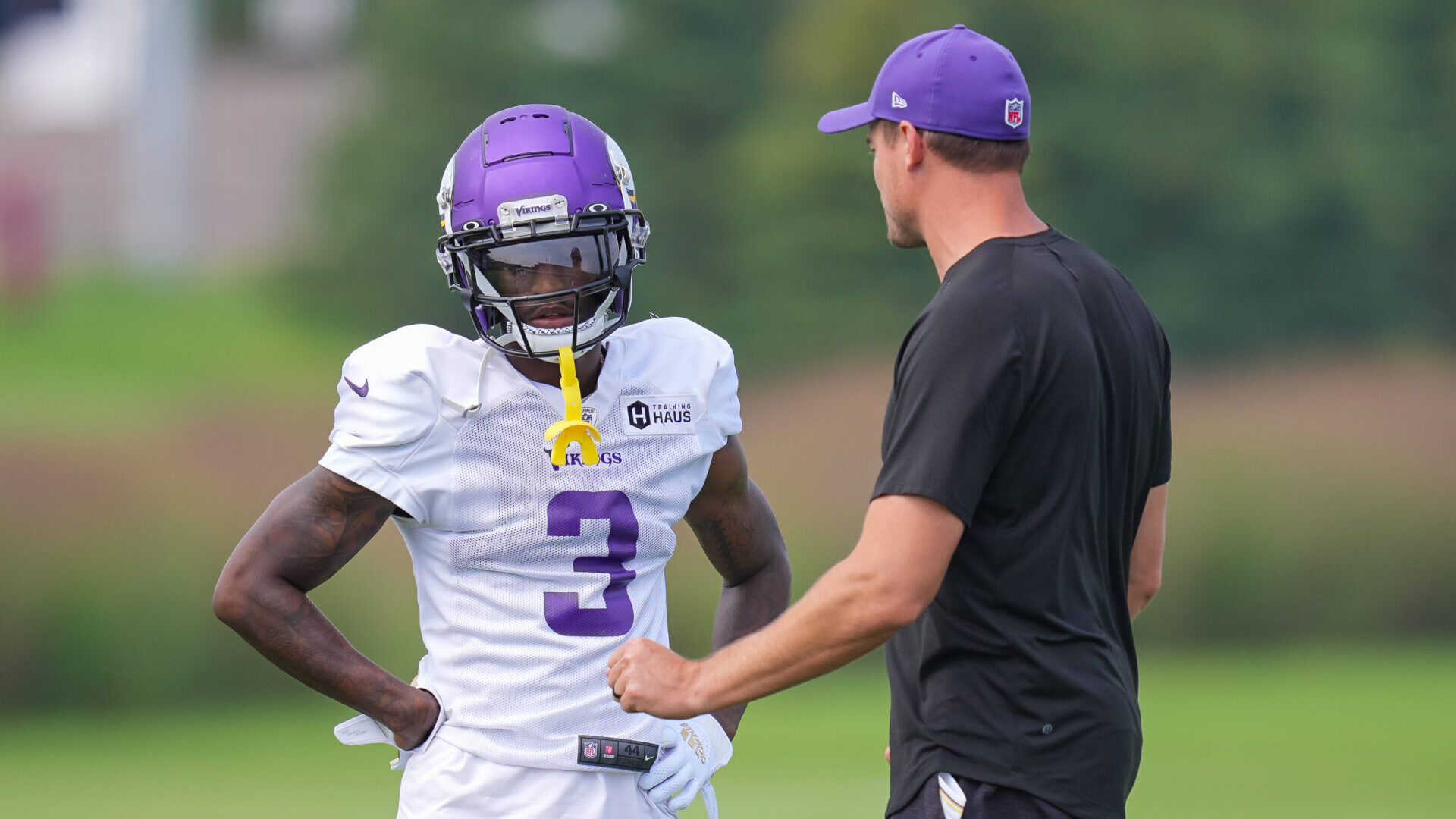
34. Jordan Addison, Minnesota Vikings
Jordan Addison is an undersized receiver taken in Round 1 by the Vikings in the 2023 NFL Draft. He was college football’s best receiver in 2021, with 100 receptions and 1,593 yards in 14 games for Pitt. He then transferred to USC as a junior in 2022, and, while his production dropped, he still led the team with 80 yards per game (second-best on the team was 56).
Think of him like a less athletic version of Devonta Smith or slightly smaller Calvin Ridley. He steps into Adam Thielen’s 107 vacated targets in Minnesota, and there’s a chance he passes Hockenson for second fiddle behind Jefferson. He has the most clear path to triple-digit targets among all the first round rookies.
35. Jaxon Smith-Njigba, Seattle Seahawks
The first receiver taken in the recent draft, JSN is a slot-only player who is dangerous after the catch. His historic sophomore season at Ohio State is slightly misleading, given that Garrett Wilson and Olave didn’t suit up for his 347-yard explosion against Utah. Still, he out-paced those two when he was younger and less experienced. Outside of that 2021 season, he was under 50 yards in his other two years, partially due to injuries.
There’s a real chance he’s off the field when the Seahawks are in two receiver sets, but if he surpasses Lockett on the target pecking order, he could have some version of the St. Brown rookie season. He shouldn’t be going much earlier than Addison and Quentin Johnston in drafts, but you shouldn’t fade an elite slot talent on one of the NFL’s better passing offenses.
36. Quentin Johnston, Los Angeles Chargers
Johnston has a tantalizing combination of a downfield route tree with truly elite yards after the catch (YAC) ability. Generally, players operating closer to the line of scrimmage like Deebo Samuel are the better YAC guys, so Johnston has a special skill set for both the NFL and fantasy football.
While he’s on a crowded Chargers depth chart, this team currently projects to lead the NFL in pass attempts, and both Allen and Williams have struggled with injuries in recent seasons. Johnston may start the year behind Josh Palmer, but he should be starting by October in arguably the best situation for receiver fantasy points.
37. Gabe Davis, Buffalo Bills
Davis’ high ankle sprain in 2022 sapped some explosiveness and hurt his production. Still, his 18 percent target share at one of the NFL’s highest aDOTs (15.3 yards) was impressive, and a marked improvement from his 11 percent target share on a 12.9 aDOT from 2021. Davis probably shouldn’t have gone in Round 4 of fantasy drafts last year, but with the improvements we saw in 2022, he shouldn’t be falling to Round 8 this year.
There’s still no true challenger for his routes on the outside in Buffalo, and the high volume deep threat for Josh Allen is a decent pick in those middle rounds of drafts.
38. Jahan Dotson, Washington Commanders
Dotson dealt with injuries throughout his rookie season, but was still a starting wide receiver anytime he was healthy. He caught a touchdown once every five passes, a rate that will surely decline over a full season, but we saw some target earning potential down the stretch.
The final five games of 2022, Dotson had the same number of targets as McLaurin, despite running routes further downfield. There’s an outside chance he emerges as the top option in this pass game, but he’s most likely a very good No. 2 in a below average pass attack.
39. Skyy Moore, Kansas City Chiefs
Juju Smith-Schuster caught 78 passes for 933 yards as Patrick Mahomes’ primary slot receiver in 2022. Skyy Moore, in a limited rookie sample, was targeted at a higher rate than Juju, slightly further down the field.
Coming from Western Michigan, it makes sense why Moore took awhile to acclimate to the NFL game. All training camp reports are that Moore is taking all the first team slot reps, so a slightly better version of Juju’s 2022 season is in play for the talented second-year player.
There’s role fragility here, and a healthy Kadarius Toney could eat into those slot snaps. However, we want upside at this stage of drafts, and Moore is a sneaky candidate for 80 receptions and 1,000 yards — with obvious touchdown upside given the Kansas City Chiefs offense.
40. George Pickens, Pittsburgh Steelers
Per route, both Diontae Johnson and Pat Freiermuth received a target about 50 percent more often than George Pickens in 2022. Pickens was running routes much further downfield, but that discrepancy is still alarming.
Like Godwin, there were questions about Pickens to start the year, since he’d been rehabbing an ACL tear. Another year removed and entering Year 2 of his NFL career, Pickens should take some reasonable steps forward. Still, it’s tough to draft the likely third option in an offense run by Kenny Pickett in Round 6 or 7 of fantasy drafts.
41. Treylon Burks, Tennessee Titans
Treylon Burks struggled with conditioning and injuries as a rookie, and the Titans brought in veteran Hopkins for the next two seasons, relegating Burks to the WR2 role in this offense. Tannehill did support fantasy relevant seasons for both AJ Brown and Corey Davis in 2020, but that was also three years ago, and before the Titans had a crumbling offensive line.
If Burks plays outside and runs a route tree focusing on posts and crossers, the patchwork offensive line could be a real detriment to his fantasy production. He flashed as a rookie and Hopkins is a heightened injury risk at this stage of his career. Burks likely does just enough to give you flex points each week, but without a Hopkins injury or a another 30 touchdown pass season from Tannehill, it’s hard to envision him giving you truly difference-making fantasy production.
42. Zay Flowers, Baltimore Ravens
Zay Flowers is undersized and shifty, and his solid numbers at Boston College were suppressed by atrocious quarterback play. The Baltimore Ravens took him in Round 1 of the draft, and he has a chance to rise above Rashod Bateman and Odell Beckham Jr. on the depth chart. TE Mark Andrews is the top target in this offense, and, even with the switch to pass-centric offensive coordinator Todd Monken, this is still a passing offense led by Lamar Jackson.
Volume could be a concern with an elite tight end and three talented wideouts all vying for reps. Bateman was incredibly efficient in limited action last year, and Bateman’s prospect profile was better than Flowers’. However, Bateman is currently not healthy enough to practice, so this could be another injury-riddled season for him.
Beckham looked like his old self to start the Super Bowl against the Bengals, before he suffered another ACL tear. He didn’t play in 2022 and is nearly 31. There’s a good chance Beckham is an efficient player who only runs 70 percent of the routes each game for preservation.
Flowers is the rookie, but in many ways he has the fewest question marks among this group. Assuming the Ravens throw more like the 2021 season, one of the three receivers should be a consistent fantasy asset like Marquise Brown was in that 2021 season alongside Andrews.
No depth chart order among these three would surprise me, but my current full season lean is Flowers then Bateman then Beckham.
43. Elijah Moore, Cleveland Browns
Moore averaged 20 fantasy points per game the final five games of his rookie season before suffering an injury and not returning. Then, the Jets drafted Garrett Wilson in Round 1, and Moore took a firm backseat. Part of Moore’s sophomore season struggles can be explained by poor quarterback play and part can be attributed to Moore’s negative comments about Zach Wilson’s passing abilities. Still, we don’t often see a player flash as a rookie then completely fall off a cliff in Year 2.
Moore is now in Cleveland, and if Deshaun Watson returns to form, and Moore’s rookie year is more indicative of his future than 2022, we are looking at an absolute steal by ADP. However, a lot needs to go right for that to happen, so Moore’s Round 8/9 ADP is a nice balance of 2022’s floor with the upside from his rookie year. He’s a player I can see myself starting each week, so I’ve taken the gamble on him more often than most at his current price tag.
44. Rashod Bateman, Baltimore Ravens
See the Flowers write-up above (No. 42).
45. Jameson Williams, Detroit Lions
Williams is a versatile field stretcher with potential for a better version of the Gabe Davis role. Williams is blazing fast and his 1,572 yard junior year at Alabama showcases his potential.
However, he’s suspended for the first six games of 2022, and he came along more slowly than expected as a rookie last year. Reports of immaturity during training camp also aren’t doing him any favors, but his skill set complements St. Brown well, and the Lions’ elite offensive line should be a positive for a downfield threat like Williams.
He could be arbitrage Davis when he returns, but he might clog your bench for six weeks and then be a rotational player with Marvin Jones on the outside. The range of outcomes here is vast, but the path is still there for WR2 fantasy production.
Tier 6: Michael Thomas
46. Michael Thomas, New Orleans Saints
Thomas needs his own tier because there is no other player like him. He set the NFL record with 149 receptions in 2019 (9.3 per game) but has played just 10 games in the three seasons since. In that limited action from 2020-2022, he’s paced for 131 targets, 95 receptions, 1,035 yards and five touchdowns over a 17-game season.
Thomas averaged 17 fantasy points per game in three games last year, though three touchdowns receiving definitely helped. Olave should be ahead of him for targets from Carr, but Carr is an accurate quarterback who should be a plus for Thomas. A healthy Thomas is most likely in your weekly starting lineup, but the past three seasons also can’t be ignored.
At the very least, draft Thomas to start him in Week 1 against a Titans team that allowed the most yards passing per game to opponents last year. He shouldn’t be on all your teams, but it’s hard not to push the button on him in Round 9 or 10 when he’s still shown fantasy WR2 ability anytime he’s healthy.
Tier 7: Some Path to Fantasy Relevance
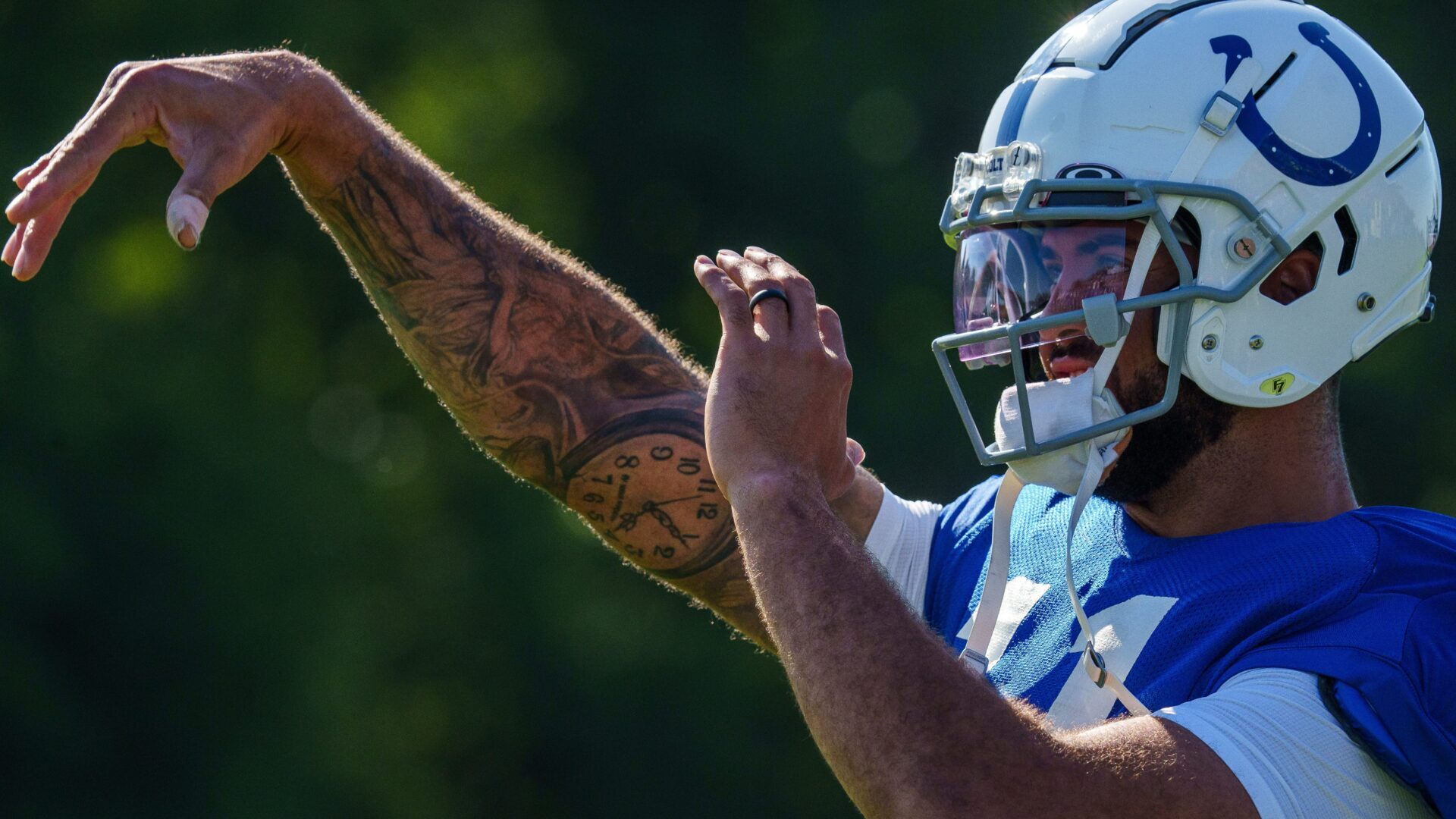
47. Michael Pittman, Indianapolis Colts
The Indianapolis Colts threw the eighth-most passes in the NFL last year, and Michael Pittman was a low-end WR2 who wasn’t an exciting player to start each week. Now, rookie QB Anthony Richardson is in the fold, and his 53.8 percent completion rate in his one college season as a starter is terrifying. Richardson has a cannon arm and the innate ability to avoid sacks and extend plays. However, this team should fall near the league bottom in pass attempts.
If Pittman could barely get it done in fantasy last year, he’s a bad bet to produce this season with a rookie passer.
48. Brandin Cooks, Dallas Cowboys
Cooks has shades of Allen Robinson, as he had a major down season and also switched teams around his age 30 season. However, Cooks still managed a 20.7 percent target share in 2022. He’s certainly behind Lamb on the Cowboys depth chart, but should still be fantasy relevant in 2023 if he’s the team’s No. 2 target.
The Cowboys have generally played at a fast pace, and they no longer have RB Ezekiel Elliott. Cooks could earn 120 targets in a great offense, or last year was the early signal of age-related decline. He’s not a player I’m clamoring to draft, but he has a long track record of WR2 production. Most likely, Cooks is someone you can start as a WR3 type, but that’s not helping you win your league.
49. Courtland Sutton, Denver Broncos
Sutton hasn’t been the same player since his 2020 ACL tear. Jeudy emerged as the more consistent player in 2022 despite dealing with more injury issues than Sutton last year.
Sutton probably holds off TE Greg Dulcich and rookie WR Marvin Mims for the No. 2 receiver role in Denver, but it’s hard to get on board with a player that looks a lot like Gabe Davis — with stiffer target competition on a worse passing offense.
Sutton is a quality spot starter, but he most likely alternates between your bench and flex spot. Other players in his range have a better high-end range of outcomes.
50. Odell Beckham Jr., Baltimore Ravens
See the Flowers write-up above (No. 42).
51. Allen Lazard, New York Jets
Lazard was the only guy for the Packers for half the season, before rookie Christian Watson finally took off. While Lazard didn’t reach some of the loftier projections, he had a respectable 21 percent target share and 1.91 yards per route run, higher than every Packer not named Watson.
With the Jets, he remains tethered to Rodgers, but should take a clear back seat to superstar Garrett Wilson. Lazard should be a bye week fill-in, and there’s some chance he combines with Wilson to vacuum up half the team’s targets. Think of him as a stable flex play with touchdown upside, with an outside chance at a better version of his 2022 season should Wilson get injured.
52. Nico Collins, Houston Texans
Nico Collins only played in 10 games last year due to injury, but he took a major step forward in his ability to command targets. Collins had an identical 25 percent targets per route run rate to DeVonta Smith, though Collins actually did it at a higher aDOT (11.2 compared to 9.8).
The Texans are starved for playmakers, and Collins appears the one likeliest to emerge for rookie QB C.J. Stroud. Collins is probably held back by quarterback play, but this team has a great offensive line, which could help a receiver like Collins who takes more time during his routes to gain separation.
Tier 8: Dart Throws
53. Jakobi Meyers, Las Vegas Raiders
Jakobi Meyers has consistently put up mid-20s target shares in Patriots' offenses without any true playmakers. In Las Vegas, Meyers will take a clear backseat to Davante Adams, though it’s worth noting that Meyers reunites with head coach Josh McDaniels, former offensive coordinator for the Patriots in 2020/2021.
The Raiders have a difficult schedule and a weak defense, so this team may throw enough for Meyers to be a weekly WR3 play alongside Adams. Most likely, he needs an Adams injury to be a worthwhile start each week.
54. Tyler Boyd, Cincinnati Bengals
Tyler Boyd is a handcuff receiver, where he becomes a fantasy WR2 type should anything happen to Chase or Higgins. Think of him as a bench stash similar to a backup running back, only Boyd has two injury outs to work with.
55. Zay Jones, Jacksonville Jaguars
Jones was barely out-targeted by Christian Kirk (7.8 to 7.6 per game) in his breakout 2022 season, but much like Boyd, he’s now a handcuff receiver. Should anything happen to Ridley or Kirk, Jones would slot in as a weekly WR2 play for fantasy football.
56. Rashee Rice, Kansas City Chiefs
Skyy Moore and Marquez Valdes-Scantling (MVS) appear to be the starters in two receiver sets. Kadarius Toney will mix in some as well, but he was injured returning a punt. Expect Toney to be used in a gadget role and on special teams. MVS is a pure field stretcher who shouldn’t handle more than four or five targets per game.
Rashee Rice is in the mix after those three, competing with Justin Watson, Richie James and Justyn Ross to be active on game days. Rice deserves the benefit of the doubt given his Round 2 draft capital, and none of the receivers ahead of him are insurmountable obstacles. Be patient if you draft Rice, since he could deliver down the stretch, but he’s most likely giving you zeroes the first month or two.
57. Kadarius Toney, Kansas City Chiefs
See the Rice write-up above (No. 56).
58. Jonathan Mingo, Carolina Panthers
Jonathan Mingo was taken in Round 2 by the Carolina Panthers, and it’s very unclear how the targets shake out in this offense. Mingo may emerge as the No. 1 option for talented rookie Bryce Young, or he could remain buried on the depth chart all year as a rotational player.
He’s a physical specimen, but he’s probably a year away from fantasy relevance after first topping 400 receiving yards as a senior at Ole Miss in 2022.
59. Marvin Mims, Denver Broncos
Mims is a small, speedy receiver who was hyper productive at Oklahoma despite never being a full time player. He may be DeSean Jackson down the line, but Denver’s most recent Round 2 draft pick is probably just better K.J. Hamler as a rookie.
Russell Wilson throws a great deep ball, and Mims should have a few top-20 fantasy weeks this year. He may not have enough consistency in 2023, but there’s a path for him to trail only Jeudy on a targets per game level by November.
60. Jayden Reed, Green Bay Packers
Jayden Reed has some Diontae Johnson to his game, as he’s an undersized, shifty receiver with eye-popping special teams numbers from college.
Reed probably emerges as the team’s WR2 behind Watson, but unless Jordan Love is better than advertised, Reed will hang out on your fantasy bench or waivers.
61. Darius Slayton, New York Giants
Darius Slayton has topped 700 receiving yards in three of his four seasons. He may get usurped by rookie Jalin Hyatt late in the year for the speedy outside role, but Slayton has enough of a track record to hold off the Round 3 draft pick.
This New York Giants offense should be better in Year 2 of the Daniel Jones-Brian Daboll connection, and the addition of TE Darren Waller should improve the overall offensive environment. Slayton could be a weekly flex play.
62. Isaiah Hodgins, New York Giants
Drafted by Buffalo in Round 6 of the 2020 draft, Isaiah Hodgins finally found his home with the Giants late in the 2022 season. He only crested six targets in one game last year but managed at least four catches and 37 yards in his final four games. The Giants have a crowded depth chart of slot receivers, but Hodgins currently profiles as the only potential X receiver on the outside. He’s a big body whose ceiling is the lite version of Mike Williams.
63. JuJu Smith-Schuster, New England Patriots
In the perfect situation in Kansas City — strong offense with no receiver competition — Smith-Schuster caught 78 passes for 933 yards and three touchdowns, finishing just outside the top-40 in fantasy points per game. He managed a 17 percent target share, which is roughly what we should expect for him in New England. Unfortunately, the New England Patriots offense is incomparable to the Chiefs, and Smith-Schuster most likely plays the majority of the snaps in a rotational role with DeVante Parker, Tyquan Thornton and Kendrick Bourne.
64. Van Jefferson, Los Angeles Rams
Van Jefferson caught 50 of his 89 targets for 802 yards and six touchdowns the year the Rams won the Super Bowl. Like most on the roster, he struggled with injuries and ineffectiveness in 2022.
The Rams have arguably the NFL’s worst defense, so they should need to throw early and often this upcoming season. Jefferson is the clear third option behind Kupp and Tyler Higbee, but he can give you 15 fantasy points on only a few targets each week, as he’s used similarly to Gabe Davis.
65. Donovan Peoples-Jones, Cleveland Browns
Donovan Peoples-Jones experienced a breakout Year 3, with 96 targets, 61 receptions, 839 yards, and three touchdowns. Looking at 2023, Elijah Moore is now in the fold, and the team also drafted WR Cedric Tillman in Round 3 of the recent NFL Draft. There’s a slight chance DPJ is ahead of Moore for targets, but most likely DPJ is now behind Cooper, Moore, and TE David Njoku most weeks.
He’s included in these rankings because there’s a chance he’s this team’s No. 2 pass game option and builds on his breakout 2022 season.
66. Michael Gallup, Dallas Cowboys
Michael Gallup feels decades removed from his 1,107-yard season in 2019. After tearing his ACL nine games into the 2021 season, he was predictably below average across the board in 2022. He has said to reporters that he now feels 100 percent healthy again, which tracks with most ACL tear timelines.
Think of him as a handcuff receiver, where he could become a weekly starter if anything happens to Lamb or Cooks.
67. Darnell Mooney, Chicago Bears
NFL insider Ari Meirov was on The 33rd Team Fantasy & Betting podcast recently, and he discussed how the Bears have been in extension talks with Darnell Mooney, but not Chase Claypool. Right now, the assumption is Mooney will be the No. 2 in this offense behind DJ Moore.
The Bears need a lot to go right with pass volume and Justin Fields needs to take several major steps forward as a passer. If this offense hits, several players will crush their fantasy ADPs, so Mooney and Claypool should be on your radar.
Mooney will likely be more consistent as the WR2 in this offense, while Claypool’s appeal is in his big frame, athleticism, and touchdown potential.
68. Chase Claypool, Chicago Beears
See the Darnell Mooney write-up above (No. 67).
Make sure you’re following Josh Larky on Twitter, and if you haven’t already, make sure you join our FREE Discord to chat fantasy football all offseason. In season, we’ll be dropping player prop bets each week, along with DFS showdown AMAs and start-sit help.
Follow The 33rd Team Podcast Network on Spotify and Apple Podcasts.












